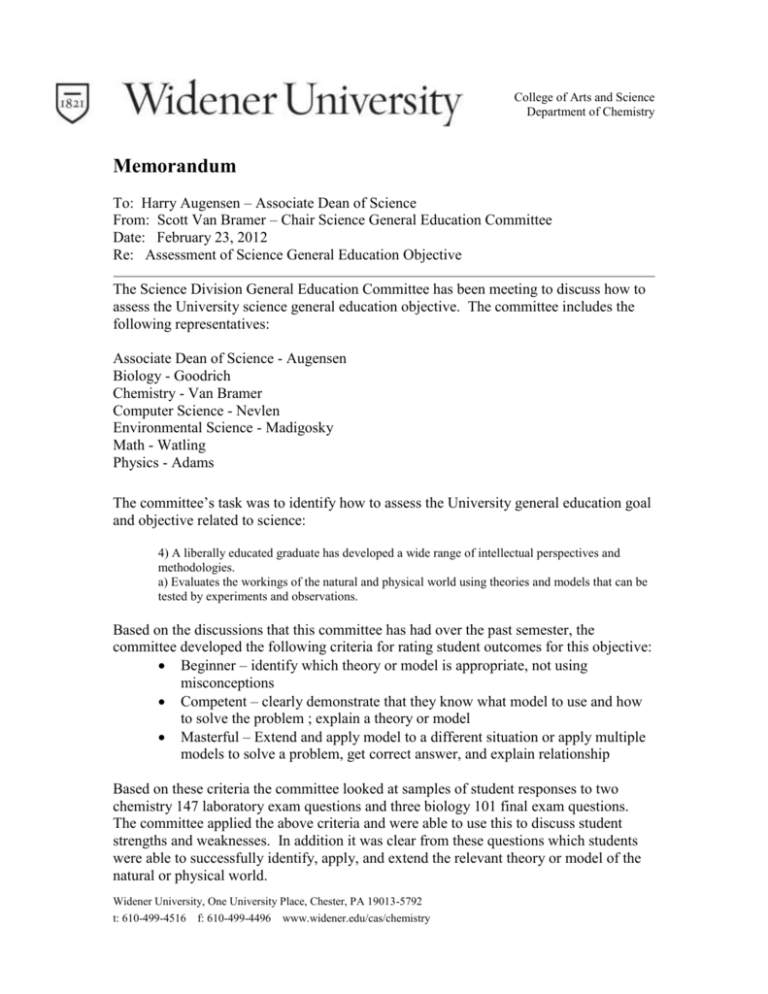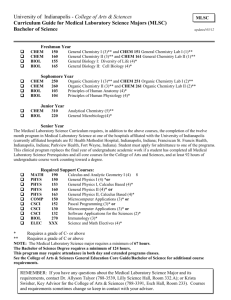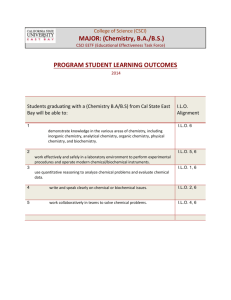Science Theories and Models
advertisement

College of Arts and Science Department of Chemistry Memorandum To: Harry Augensen – Associate Dean of Science From: Scott Van Bramer – Chair Science General Education Committee Date: February 23, 2012 Re: Assessment of Science General Education Objective The Science Division General Education Committee has been meeting to discuss how to assess the University science general education objective. The committee includes the following representatives: Associate Dean of Science - Augensen Biology - Goodrich Chemistry - Van Bramer Computer Science - Nevlen Environmental Science - Madigosky Math - Watling Physics - Adams The committee’s task was to identify how to assess the University general education goal and objective related to science: 4) A liberally educated graduate has developed a wide range of intellectual perspectives and methodologies. a) Evaluates the workings of the natural and physical world using theories and models that can be tested by experiments and observations. Based on the discussions that this committee has had over the past semester, the committee developed the following criteria for rating student outcomes for this objective: Beginner – identify which theory or model is appropriate, not using misconceptions Competent – clearly demonstrate that they know what model to use and how to solve the problem ; explain a theory or model Masterful – Extend and apply model to a different situation or apply multiple models to solve a problem, get correct answer, and explain relationship Based on these criteria the committee looked at samples of student responses to two chemistry 147 laboratory exam questions and three biology 101 final exam questions. The committee applied the above criteria and were able to use this to discuss student strengths and weaknesses. In addition it was clear from these questions which students were able to successfully identify, apply, and extend the relevant theory or model of the natural or physical world. Widener University, One University Place, Chester, PA 19013-5792 t: 610-499-4516 f: 610-499-4496 www.widener.edu/cas/chemistry Based on this experience the committee recommends the following pilot to test the viability of this assessment model: 1. During the spring 2012 semester interested faculty identify a science course in their discipline that fulfills the science general education objective. 2. These faculty identify student work that could be used as an assessment point 3. Faculty select student work for assessment. For large classes this may be a random sample of student work. It could be student response to an exam question, a lab report, or any other easily captured student work. 4. The faculty evaluate the student work using the criteria listed above. 5. The faculty discuss the student outcomes from this assessment and summarize their findings and any suggestions or recommendations based on those findings. 6. These reports should be sent to the science general education committee, which will review these reports and make recommendations to the science faculty. The committee developed this plan based on the following discussions. Science Theories and Models The committee started by discussing theories and models used in different general education science courses. The following list shows the variety of different theories and models that are used in some science courses. This list is not intended to be complete, but to provide an idea of the variety of topics included in science courses. Biology Evolution Form follows Function DNA to RNA to Protein "Central Dogma" Population dynamics homeostasis Physics Newton's Laws Light Matter Big Bang The particle nature of matter Chemistry the particle nature of matter conservation of mass, matter, and energy atomic and molecular theory kinetic/molecular theory Widener University, One University Place, Chester, PA 19013-5792 t: 610-499-4516 f: 610-499-4496 www.widener.edu/cas/chemistry intermolecular forces bonding theories (ionic, covalent, molecular, metal etc.) particulate, macroscopic and symbolic models Environmental Science plate tectonics Math proportions the derivative as a rate of change simple trig models related rates optimization Computer Science Programming in computer science involves implementing and sometimes creating an algorithm. Although not all algorithms model the real world many do. Quantitative scientific laws are descriptions which are often realized numerically using computer algorithms. In CSCI 130, Computer Forensics, statistical and cryptological analysis and data manipulation is done using standard software. Data analysis often requires statistics. Data processing is of course a very common objective of a computer program. Programs which process data including those implementing standard statistical anaylses are written in the computer programming courses CSCI 125, 131, 143, 151 and 152. Some programs are also written in CSCI 126, Women in Computing. Probabilistic models such as Mendelian genetics are implemented using random number generation. Such simulations are done in the CSCI 126, 131, 143, 151 and 152. Science Courses Next the committee compiled a listing of introductory Science courses that emphasize the general education objective to “Evaluate the workings of the natural and physical world using theories and models that can be tested by experiments and observations.” Based on these conversations, the committee developed the following list of courses: Course No. Title BIOL 101 BIOL 107 BIOL 108 BIOL 113 BIOL 115 Prin Biol Systems Biology & Society Marine Diversity Evolution Human Nutrition CHEM 101-104 CHEM 105/106 Biochemistry CHEM 145-148 CHEM 188 Fundamentals of Chemistry General Organic and CHEM 100 CHEM 111 Chemistry &Everyday Life Implications of Chemistry Lab CSCI 125 Alice Animation/Virtual Worlds - Widener University, One University Place, Chester, PA 19013-5792 t: 610-499-4516 f: 610-499-4496 www.widener.edu/cas/chemistry General Chemistry Sustainable Chemistry CSCI 126 CSCI 130 CSCI 131 Women in Computing Intro to Computer Forensics Intro to Computers - Python ENVR 100 Intro Environmental Science ENVR 104 Natural Disasters ENVR 171 Principles Envr Science ENVR 201 Environmental Geology ENVR 207 Oceanography ENVR/PHYS 209 Meteorology ESSC 103 Planet Earth ESSC/PHYS 108 Intro Astronomy ESSC/PHYS 109 Intro Weather & Climate MATH 116 MATH 120 MATH 131 MATH 141 Nature of Mathematics Precalculus Calculus with Review I Calculus I PHYS 120 PHYS/SCI 130 PHYS 141/142 Conceptual Physics Concepts Music & Sound College Physics SCI 107 Food Science I SCI 125 Introduction to Forensic Science SCI 130 Concepts Music & Sound Assessment Opportunities Next the committee discussed possible assessment points for evaluating students ability to “evaluate the workings of the natural and physical world using theories and models that can be tested by experiments and observations”. Ideas the committee developed include: Essay exam questions quiz lab report – discussion Ideally this includes a written explanation, not just calculations Explain your answer questions Long answer questions Discussions Oral reports Assessment Criteria Finally the committee discussed possible criteria that could be used to evaluate student proficiency related to the science objective. During this discussion it was clear that assessment of student work requires special knowledge so that this evaluation must be done by faculty in the field. The discussion focused around the need for this assessment to include the following points: Evidence to support conclusion with appropriate model Not using misconceptions in the explanation Extend and apply model to new or different situation Evidence based decision – not an opinion Widener University, One University Place, Chester, PA 19013-5792 t: 610-499-4516 f: 610-499-4496 www.widener.edu/cas/chemistry









